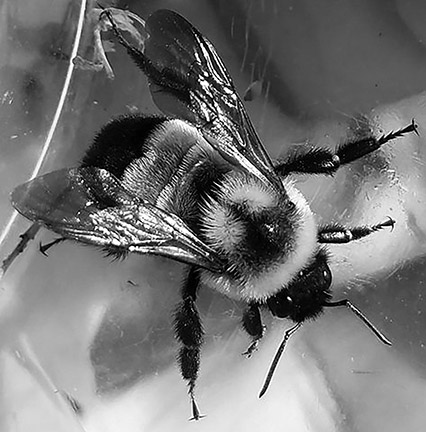Rusty Patched Bumble Bee becomes a household name
Published on May 9, 2022 at 2:25pm CDT
Growing Green
By Robin Trott, Extension Educator

Rusty Patched Bumble Bee.
Many of the calls I receive during the growing season deal with insects. One you might not see, but should keep your eye out for, is the Rusty Patched Bumble Bee. Dr. Elaine Evens, UMN Professor specializing in native and wild bee biology and bumble bee management, says that before the year 2000, the rusty patched bumble bee, Bombus affinis, was a common sight through most of Minnesota, across the east to the Atlantic Ocean and south through the Appalachian Mountains. Suddenly, around the year 2000, they disappeared across their entire range. After 10 years of looking, conservationists and bumble bee biologists found rusty patched bumble bees again, primarily in and around urban centers in the Midwest, including the Twin Cities.
Though still here, current rusty patched populations are a shadow of their former selves, having lost over 95% of their range and experienced over a 90% decrease in abundance. In 2017, the rusty patched bumble bee was granted endangered status by the U.S. Fish and Wildlife Services. In 2019, the rusty patched bumble bee was designated the Minnesota state bee.
How can you help the recovery of this endangered species?
You can help find rusty patched bumble bee locations to inform recovery efforts during the Great Backyard Bumble Bee Count from July 24 to Aug. 2. Find a patch of flowers. Take photos of every bumble bee you see for 15 minutes. Share your findings with the Backyard Bumble Bee Count on iNaturalist. More details here: https://backyardbbcount.wixsite.com/bumblebeecount.
Hopefully, working together, we can prevent extinction of this unique species. Here are some resources to learn more about rusty patched bumble bees: https://www.fws.gov/midwest/Endangered/insects/rpbb/.
Appearance
Rusty patched bumble bees can be distinguished from other bumble bees by two features: 1. a rusty patch in the middle of the 2nd abdominal segment, and 2. a T-shaped area of black hairs on the thorax. Males and workers have similar color patterns, but the queens have different coloration.
Fun facts
In 2018, a total of 471 rusty patched bumble bees were seen anywhere in the world. 165 of these were in Minnesota. This represents 35% of all documented rusty patched bumble bee individuals.
To learn more about rusty patched bumble bee identification visit these links
• https://beelab.umn.edu/rusty-patched-bumble-bee
• https://www.youtube.com/watch?v=9E7j1_kMbAs
• https://z.umn.edu/bumblebeesofmn
• http://apps.extension.umn.edu/environment/citizen-science/bee-atlas/bumb.
* * * * * * * * * * * * *
Honey bees cannot pollinate eggplant and tomato flowers; bumblebees can. So, whenever you eat a tomato…thank a bumblebee. ~April Pulley Sayre




